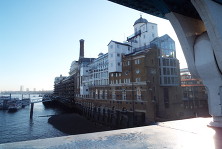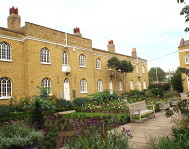








The Tibetan Peace Garden
The Tibetan Peace Garden was created by the Tibet Foundation and opened and consecrated by the Dalai Lama in 1999. It stands within the Geraldine Mary Harmsworth Park in the shadow of the Imperial War Museum. Also known as Samten Kyil, Garden of Contemplation, it is intended both as a place for the individuals to enjoy peace and tranquillity and to commemorate one of the principal teachings of the Dalai Lama - the need to create understanding between different cultures and to establish places of peace and harmony in the world. At the entrance to the garden is the Language Pillar, based on a 9th century treaty stone in Lhasa, where a message from the Dalai
Lama is inscribed in Tibetan, English, Chinese and Hindi. While the inscription makes specific reference to the people of Tibet, the message is universal:
“Conflicts and mistrust have plagued the past century, which has brought immeasurable human suffering and environmental destruction. It is in the interests of all of us on this planet that we make a joint effort to turn the next century into an era of peace and harmony.
…
“May [this pillar] remain as a symbol to remind us that human survival depends on living in harmony and always choosing the path of non-violence in resolving our differences."
At the centre of the garden is a bronze cast of the Kalachakra Mandala, a universal symbol in Buddhism. Around the Mandala are eight meditation seats which represent the noble eightfold path; right view, thought, speech, action, livelihood, effort, mindfulness and concentration. To balance the Buddhist design and symbolism and create harmony are four contemporary western sculptures that represent the four elements of air, fire, earth and water. The gardens are planted with herbs and plants from Tibet and the Himalayan regions, while the pergola is covered with climbing plants, that include jasmine, honeysuckle and scented roses.
Web discoveries
- UK Casino Not On Gamstop
- UK Casino Not On Gamstop
- Non Gamstop Casino
- Casinos Not On Gamstop
- Non Gamstop Casinos
- Non Gamstop Casinos
- Non Gamstop Casino
- Casino Sites Not On Gamstop
- Slots Not On Gamstop
- Casinos Not On Gamstop
- UK Betting Sites Not On Gamstop
- UK Casino Not On Gamstop
- Best Non Gamstop Casinos
- Betting Sites
- Non Gamstop Casino Sites UK
- Best Non Gamstop Casinos
- Non Gamstop Casino
- Casinos Not On Gamstop
- Non Gamstop Casino Sites UK